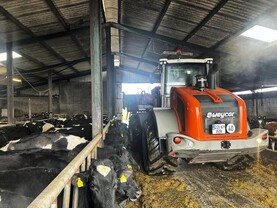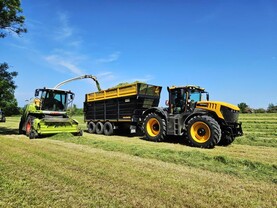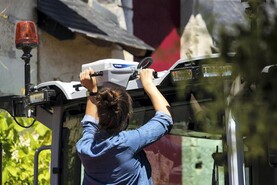Last week, JCB showcased its latest developments and updates for its Telemaster, Loadall and Fastrac ranges, including an all-new 525-60 electric Loadall model. Simon Henley attended the event held by JCB at Rocester in England.
The latest updates from JCB arrive as the company introduces Stage V engine emission compliance across its entire range of products.
But don’t be fooled into thinking these updates are limited to a cleaner exhaust, a fresh lick of paint and a few fancy electronic gadgets.
TM420S/TM320S
The biggest changes of all come to the firm’s pivot-steer Telemaster (TM) range, which introduces the new TM420S and an improved version of the popular TM320S.
Starting with the range-topping model, the new TM 420S gets a 170hp derivative of JCB’s 4.8L four-pot engine and a brand-new JCB eight-speed powershift transmission with torque-lock available in all eight ratios.
Unique to the TM420S is a new heavy-duty drop box and a super-duty ZF-derived torque convertor.
There are also upgraded radiators and coolers to match the new model’s additional power.
Lift for the regenerative hydraulic system is now provided by a new 100cc hydraulic pump, which provides 160l/minute with maximum flow at just 1,700rpm. .jpg)
The TM320S also benefits from more power (150hp) and comes equipped with the new eight-speed powershift gearbox.
Mounted on JCB PD70 axles, it can also be specified with 40km/h or 50km/h capability and provides 140l/min of hydraulic power.
All TM models benefit from a new cab design, which retains the old cab’s silhouette.
The new cab features a lower seat pan, improved overhead visibility, a new adjustable steering column design and a new B-pillar control display, which replaces the previous Carling-made rocker switches with touch buttons integrated into a membrane control panel.
According to JCB, the new switches offer more functions with less gimmicks and include more features to improve operator performance.
A new programmable thumb-button on the JCB joystick enables the operator to assign a melee of functions for on-off activation, such as turning on work lights when entering dark sheds, activating the torque-convertor lock on the silage pit or answering the phone using the integrated Bluetooth system.
There’s a new LED light package with automatic boom light activation, automatic reversing lights, a reversing camera and a new dip and dazzle feature on the headlight stalk.
The HVAC system has been redesigned with new ducts and filters, which prevent unwanted blockages, and there’s a new electronic temperature controller which eliminates the previous cable system. .jpg)
The new Electric Loadall
From an environmental perspective, the big news is the introduction of JCB’s first fully electric Loadall model.
Similar in appearance to its diesel stablemate, the electric version has been developed with an all-new chassis, which is styled to suit the JCB product image.
The new design features a 22Kw motor, which is used to power an 80l/min gear-type hydraulic pump located behind the cab. Hydraulic tank capacity is 44l.
A second 17Kw electric motor located to the right of the cab behind the front axle powers a drop-box, which provides drive to all four wheels.
According to JCB, the combination of two electric motors enables the ground drive and hydraulic system to operate independently, so operational performance is never compromised.
Power to the motors is provided by a 24Kw/96V (5,000-cycle) Joung-Heinrich battery, located in the base of what would otherwise be the engine bay.
An on-board 3Kw charger (240-volt/ 16-amp input) is standard equipment.
JCB claims its statistics reveal that 90% of diesel 525-60 Loadall users would achieve a full day’s work using the electric variant.
Charging time from 0% to 100% is eight hours. However, the battery can be topped up at any time without harming it.
All machines have a rapid-charge plug for use with an optional three-phase off-board charger, which reduces charging times to 1.5 hours.
A brief test-drive showed the electric loader offers the same precise controllability of its diesel counterpart.
Thanks to the operational characteristics of electric motors, maximum hydraulic power comes as soon as the joystick is activated, providing uncompromised tear-out and lifting power in almost eerie silence. 
Fastrac updates
Besides benefitting from an updated 8.4L Sisu engine, which introduces Stage V emission compliance with DPF technology, the range-topping JCB 8330 Fastrac (330hp) now comes with the JCB double-acting advanced suspension system used on the Fastrac 4000-Series, doubling its rear deck capacity to 5,000kg.
The new 8000-Series suspension system features larger hydraulic cylinders than those used on the front suspension of the 4000-Series, mounted on a heavy-duty Spicer front axle, which has been fitted with an anti-roll bar for increased stability at maximum speed (70km/h).
Designed to automatically maintain the 50:50 weight distribution between the front and rear at all times, the new double-acting system on both the front and rear axles replaces the single-acting rear and front coil-spring set-up used on previous models.
The Fastrac 4000-Series also attains Stage V emission compliance with the introduction of DPF technology and the debut of hydraulic tappets, extending service intervals for its Sisu engine to 600 hours.
The 4000-Series now features heavier-duty Wrexham-built JCB axles, which introduce a hydraulically activated front differential lock and higher steering ram pressure.
A further development of the 4000-Series Fastrac introduces twin Trimble RTK units for independent front and rear axle steering control, using GPS guidance.
The benefit of this new concept, which has already been successfully trialled in the UK, is that controlling the axles individually allows the tractor to be operated in twin-steer or crab-steer modes, providing greater working accuracy on inclines or undulating terrain.
This has proven particularly successful with large-scale growers, who are establishing beds for root crop, vegetable or flower production. 
JCB 403 meets Stage V
Finally, it’s the popular JCB 403 Plus compact loader which has been updated with a new 2.4L Perkins three-cylinder Stage V engine.
Rated at 50hp, the loader offers a maximum speed of 30km/h and 60l/min of hydraulic power.
Available with a variety of attachment hitches, the 403 Plus can be specified with LED lighting, a glazed and heated cab, or a ROPS option which folds down to provide access into low buildings.






 This is a subscriber-only article
This is a subscriber-only article










SHARING OPTIONS: